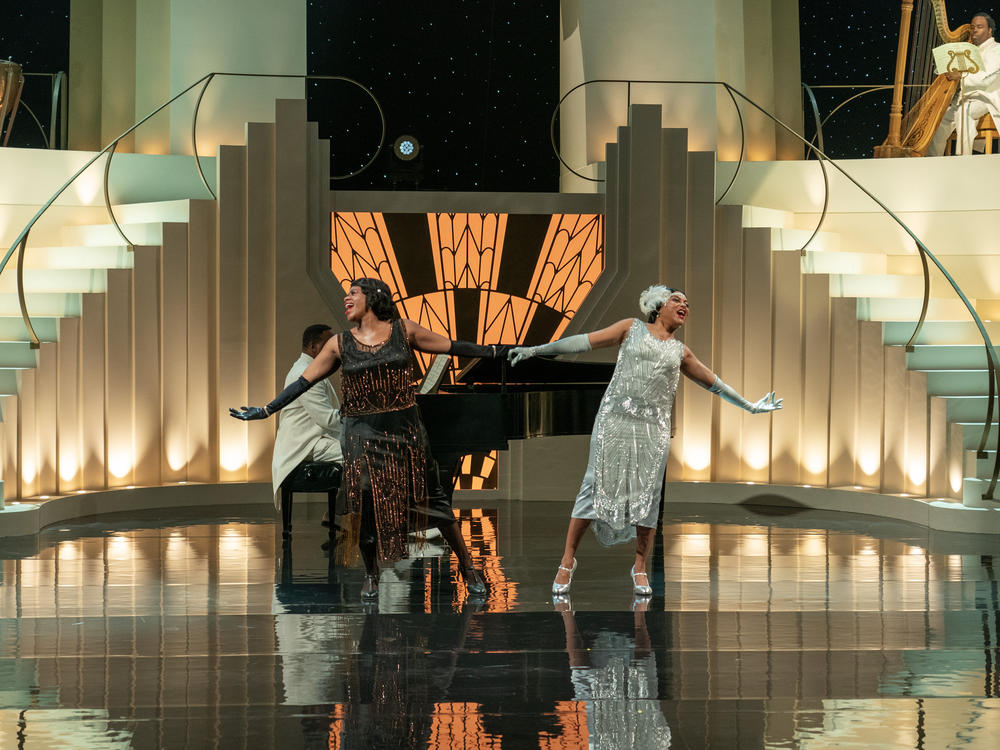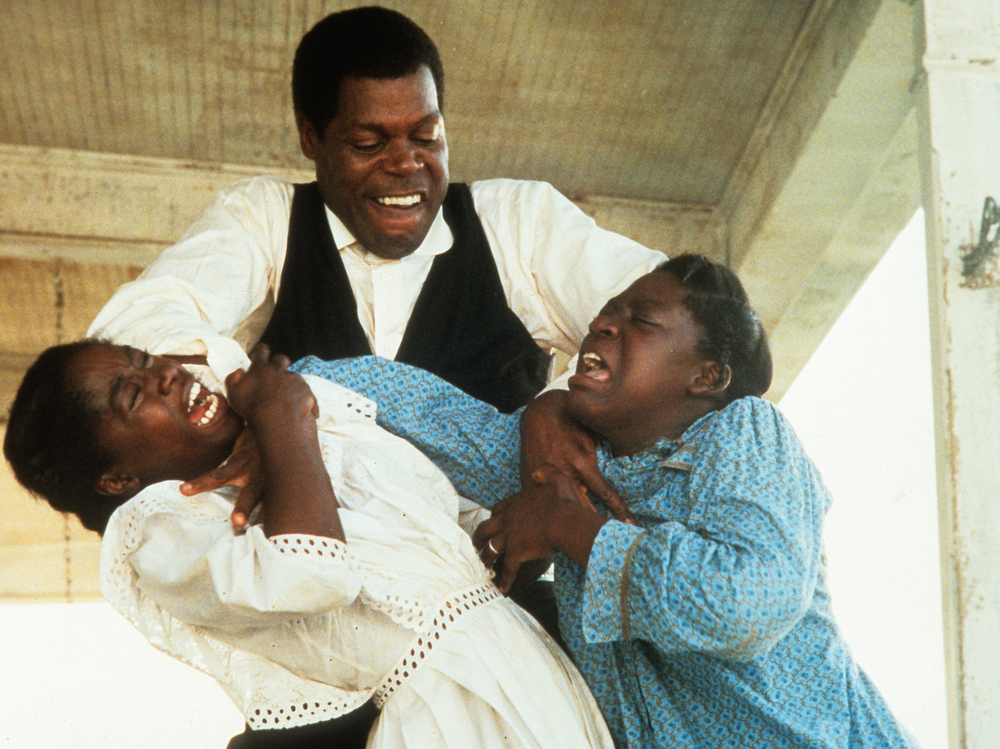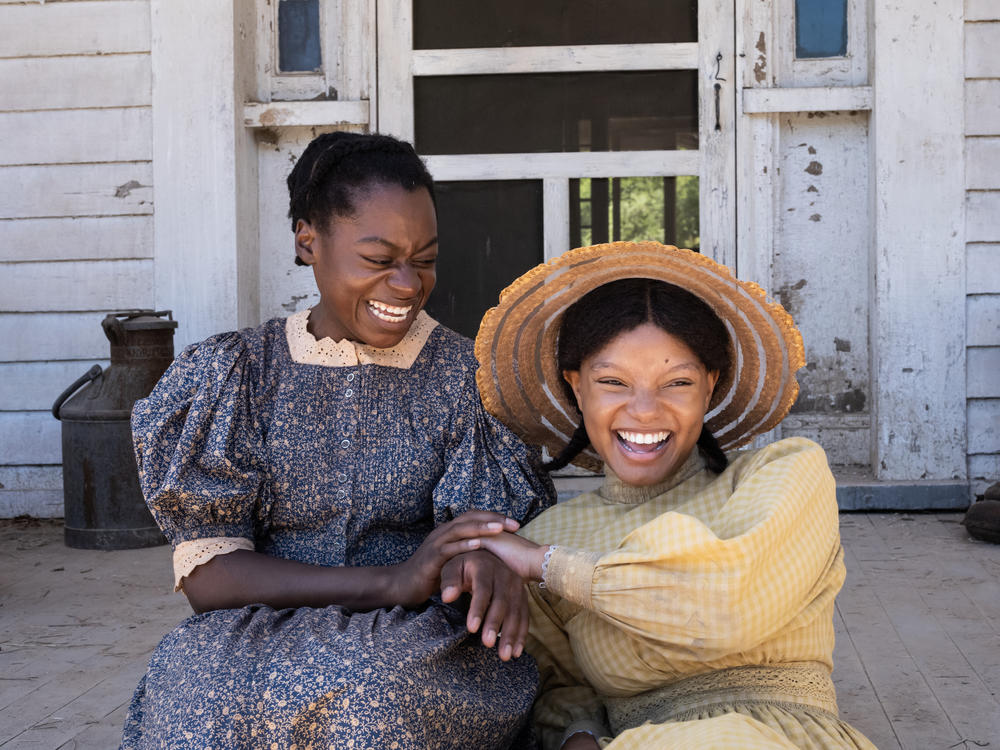Section Branding
Header Content
The new 'Color Purple' exudes joy, but dances past some deeper complexities
Primary Content
A key to understanding what director Blitz Bazawule might have envisioned for his retelling of The Color Purple, an adaptation of the Tony-winning Broadway production (itself an adaptation of Alice Walker's Pulitzer-winning novel), might lie in a brief moment during the pivotal dinner table scene.
For the first time in her life, Celie (Fantasia Barrino) has finally mustered the courage to stand up to Mister (Colman Domingo), the abusive older man she was forced to marry as a teenager. She does so in front of their entire inner circle, which includes Mister's sometime mistress Shug (Taraji P. Henson), his son Harpo (Corey Hawkins), and Harpo's ex Sofia (Danielle Brooks), who's been all but broken by experiencing years of unjust imprisonment.
As Celie hurls an insult at Mister – it concerns the bowel movements of horses – Sofia suddenly bursts into uncontrollable laughter for a few seconds, only to melt seamlessly into unmistakable sobs. At this instance in my densely packed screening of the film, a quiet, enraptured hush fell over the audience. Brooks' embodiment of this pendulum swing of emotions rattles, in a powerful way. As Sofia graciously thanks Celie for visiting her all those years she was in jail, joy and pain live side-by-side, "one in the same."
The scene is a distillation of an axiom often repeated in Black circles: that humor is our way to keep from crying, a way to deal with the tragedy and traumas that so often come with being Black in America. Richard Pryor's standup famously drew laughter out of retelling horrifying lived experiences, blurring that line between joy and pain.
This new, lively reincarnation of The Color Purple seems to be trying to strike that balance in presenting the happy with the sad throughout the entire film, though it doesn't often succeed as well as that dinner scene. There are no grand diversions from Walker's original text. The traumatic details are all pretty much as one will remember them: Celie (played as a teen by Phylicia Pearl Mpasi) is impregnated twice by Alfonso (Deon Cole), the man she knows as her father, and forced to give up both babies as soon as she gives birth; is then married away to another abusive man, Mister; and for years is torn apart from her best friend and sister Nettie (a vibrant Halle Bailey plays her younger self), because Nettie fights back when Mister tries to rape her and then kicks her off his farm.
But while the subject matter hasn't changed, the tone is a remarkable departure from the book and its once-polarizing 1985 movie adaptation directed by Steven Spielberg. While both previous iterations employed levity in their own ways (and Spielberg and screenwriter Menno Meyjes, both being white, were taken to task for it, accused of making the Black men characters out to be buffoons), Bazawule's take is decidedly glossier and more cheerful.
When this works, it works. His aesthetic eye is vivid and colorful, opening up Celie's world with energetic ensemble musical numbers which give a sense of a bustling Black community that exists beyond her suffocating life with Mister and his rambunctious kids. (Legendary choreographer Fatima Robinson is at the top of her game here, working with Adrian Wiltshire and Tia Rivera.) There are lighthearted interactions played up for laughs, like the constant bickering/flirtation between Sofia and Harpo, and exultations of pleasure, as conveyed in Henson's dynamic performance as the bold and free-wheeling club singer Shug Avery. Celie and Shug get their own romantic duet set against the backdrop of a 1930s Hollywood musical.
Yet there are some curious tonal decisions that seem to be borne, at least in part, out of its mode as a musical theater adaptation, as well as out of an attempt to address some of the loudest critiques of the 1985 film. The instances of domestic violence in which a character is hit are staged broadly – or rather, as if the actors are on an actual live performance stage, playing to the rafters: Big windups and dramatic slaps that for this viewer conjured the over-the-top manga-inspired violence of The Boondocks. The presumably unintentional effect is to literally knock the wind out of the abuse, to defang it so it doesn't feel quite so real.
Then there's the famous scene where young Celie and Nettie are forcibly separated, which is remarkably subdued and truncated given the circumstances. In this case, it takes place during a rainstorm, with Mister wielding a shotgun as he demands Nettie leave his farm. But its emotional impact is dull; the exchange hurries by so quickly and almost perfunctorily as to erase any dramatic tension that should come out of this life-altering severing of a sisterly bond. Before there's any time for young Celie to process what it means, it's on to the next scene.
Contrast this with the same scene in Spielberg's film – guttural cries of anguish punctuate a prolonged sequence of cruelty, as the imposing figure of Danny Glover's Mister physically hauls Nettie (Akosua Busia) off his farm, with Celie (Desreta Jackson) dragging behind him while grasping onto her sister's hands for dear life. The effect is excruciating, yet profound. Celie and Nettie's pain is wholly felt and lived in, which in turn makes their reunion all those years later that much stronger.
Admittedly, it feels odd and even a little wrong to criticize a film for minimizing the trauma against Black women that's shown on screen. But exploitation and exploration are not the same, and with little exception, Bazawule and his screenwriter Marcus Gardley seem reluctant to sit too long in the discomforting facets of this story, choosing instead to over-index on "joy." As Taraji P. Henson bluntly put it recently: "The first movie missed culturally. We don't wallow in the muck ... We laugh, we sing, we go to church, we dance, we celebrate, we fight for joy ..." (Spielberg, for what it's worth, is among this film's executive producers.)
Considering the long, sordid history of Black pain on screen, this resistance is unsurprising. Henson is reverberating one of the many grievances some Black audience members had with the 1985 movie. A recurring thread in the controversy was the stark gender divide in reactions to the film's depiction of gendered violence, intergenerational trauma, and queer romance – many Black women felt seen on the page and screen for the first time; many straight Black men felt attacked and demonized for the hundredth time. Yet the art and its themes revisited in 2023 shouldn't be too afraid to embrace that tension – after all, Walker's original text exists precisely to shine a light upon the muck, as well as the triumph over it.
The issue goes deeper than the depiction of "muck" anyway, spilling over into the film's overall pacing and transitioning between action and music. Another axiom, this one understood by musical theater enthusiasts, suggests dialogue becomes song when words aren't enough, and song gives way to dance when lyrics don't cut it. A couple of songs spring prematurely, before the scenes have time to build any emotional resonance – for one, "She Be Mine," a ballad sung by young Celie about the loss of her babies. Still others end abruptly just as the song begins to ramp up, like Harpo's propulsive building-a-house number "Workin'." (Hawkins is yet another standout in this ridiculously stacked cast.)
Even still, there's enough here to recommend it to anyone who's loved some previous version of the original story. This Color Purple reincarnation differs from many other remakes and reboots that have washed upon the public's shores. Its existence isn't merely a bid for nostalgia – though that's of course a piece of it – but an extension of an artifact that's deeply embedded and integral within Black America's cultural canon. It carries the weight of four decades' worth of fierce debates, divergent interpretations, and scholarly analysis.
Perhaps most notable of all, there's a deep and persevering connection to countless Black women and queer people who've seen themselves in this work about overcoming traumas.
Reimagined art can and often does buckle under so much heft and expectation, overcome by the strain for "importance" and focus on "legacy" to the point that the artistry seems like an afterthought. In this regard, Bazawule's version narrowly avoids collapse, thanks to stellar performances and a few musical numbers that breathe exuberant new life into Walker's text.
Copyright 2023 NPR. To see more, visit https://www.npr.org.
Correction
An earlier version of this story stated that in the plot of The Color Purple Celie was impregnated twice by her father. Though she believed the man was her biological father at the time of the rape, she learns later that he is her stepfather.




